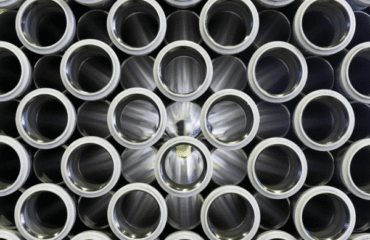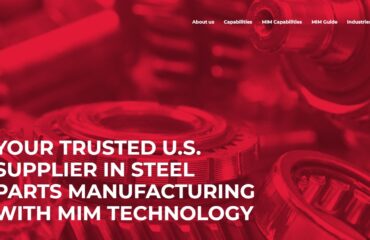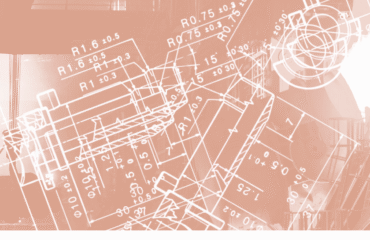

Metal Injection Molding (MIM) is a powerful technology for producing small and medium-sized metal parts with complex geometries and tight tolerances. It combines the design freedom with the strength of sintered metal, making it ideal for high-precision components in industries like automotive, aerospace, and medical devices.
In this article, we break down each stage of the MIM process as carried out at Ecrimesa Group, from mold design to final finishing, to show how powder becomes a fully finished metal part.
The following image shows the MIM process.

MIM explained step by step
1. Mold fabrication: the foundation of precision
The MIM process begins with the design and manufacture of a mold. These molds are built from high-strength steel and are more complex than those used in other injection process. Each cavity must be slightly oversized to compensate for shrinkage during later stages of the process.
Depending on the part geometry, a mold may contain between 1 and 10 cavities, most often between 2 and 4, with typical cycle times ranging from 15 to 60 seconds.
Following specific design rules at this stage is crucial to ensure a stable injection process and a defect-free final part.
2. Feedstock: the engineered raw material
MIM feedstock consists of metal powder (maximum particle size 32 µm; 80% under 22 µm) mixed with a binder system made of thermoplastics, waxes, and polymers. This mixture is granulated into pellets for injection.
Accurate feedstock characterization is essential. It directly affects injection and sintering parameters and, ultimately, dimensional tolerances, density, and part consistency.
3. Injection Molding: shaping the green part
The feedstock is injected into the mold under controlled pressure and temperature conditions. These parameters are carefully adapted to the geometry of each part.
The result is the green part, which replicates the final shape but still contains the binder. It also undergoes an initial shrinkage during demolding, typically around 0.7–0.9% for carbon or low-alloy steels and about 0.4% for stainless steels.
The quality of this step is highly dependent on the manufacturer’s expertise and process control.


4. De-binding: transition to the brown part
Next, the binder must be removed. De-binding can be thermal, solvent-based, water-based, or, as preferred at Ecrimesa Group, catalytic.
In our facilities, catalytic de-binding is performed in a controlled atmosphere of nitrogen and nitric acid at 120ºC. The main binder component (POM) is vaporized, leaving behind a fragile and porous brown part.
Continuous furnaces allows parts to move directly from de-binding to sintering without manual handling , a crucial factor at this delicate stage when parts are especially vulnerable to deformation.
Residual secondary binders help preserve the shape and are eliminated at the start of the sintering phase.
5. Sintering: achieving final properties
During sintering, the brown part is exposed to high temperatures under a controlled gas atmosphere (typically H₂ or N₂), causing the metal particles to fuse. This step eliminates any remaining binders and densifies the part to near-theoretical levels (95–98%).
A second, significant contraction occurs here:
- Carbon and low-alloy steels:
- Mold to final part: 1.2165
- Green to final part: 1.205
- Stainless steels:
- Mold to final: 1.166
- Green to final: 1.160
The positioning of parts during sintering affects the dimensional outcome, so this stage requires precise planning and process definition.

During the sintering, the second and definite cotraction occurs, resulting in the final dimensions defined before the beginning of the process. With carbon and low-alloy steels, the contraction factor between mold and final piece amounts to 1.2165, and 1.205 between the green form and the final piece. With stainless steels, the contraction factor is 1.166 between mold and final piece, and 1.160 between green part and final product.
Below, you can see some pictures of our continuous furnace in our facilities in Europe.


6. Final Operations: from sintered to finished
Post-sintering, parts may undergo additional processes to meet customer requirements. These include:
- Heat treatments (hardening, annealing, tempering)
- Machining for tight tolerances
- Surface finishing such as polishing or pickling
All these operations are handled in-house. Our facilities include a modern heat treatment plant, machining centers, and metrology labs to ensure quality at every step.
MimecriUSA: your trusted partner for MIM Manufacturing
MimecriUSA is a U.S.-based manufacturer focused exclusively on Metal Injection Molding (MIM) technology. From our facility in Thomasville, Georgia, we supply custom MIM parts to leading companies across aerospace, automotive, medical, and defense sectors.
We are your American manufacturer of MIM parts, ready to deliver high-volume or custom runs with full support, from design to delivery. Need expert guidance on whether MIM is the right solution for your part? Our engineering team is ready to help you assess feasibility, optimize your design, and streamline production.





 by
by